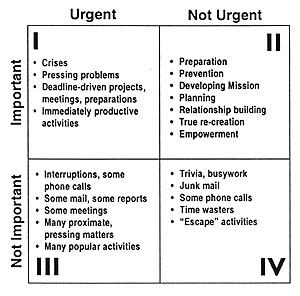Time Management - Important and Urgent
Time management and effectiveness can be improved by using a decision matrix that helps sort out priorities. The most important items on a to do list are those activites that are both “important” and “urgent”.
- Important activities have an outcome that leads to achieving one’s goals.
- Urgent activities demand immediate attention, and are usually associated with achieving someone else's goals.
By defining which activities are important and which are urgent, we can overcome the natural tendency to focus on unimportant urgent activities.
This Time Management Matrix is a handy tool and reminder to post on your wall or computer screen.
History
Stephen Covey, the management guru, popularized the Eisenhower’s Decision Principle in his book, "The 7 Habits of Highly Effective People". Covey created a decision matrix that consists of a square divided into four boxes:
- Urgent/Important,
- Not Urgent/Important,
- Urgent/Not Important, and
- Not Urgent/Not Important:
In a 1954 President Eisenhower, who was quoting a university president, said: "I have two kinds of problems: the urgent and the important. The urgent are not important, and the important are never urgent." Eisenhower demonstrated his organizational abilities, effectiveness and ability to get important and urgent things done both as the Supreme Commander of Allied Forces in WW II in Europe and as US President for eight years.
Challenges to Implement
The first challenge is to get beyond being driven by only urgent tasks and demands – crisis, deadlines and last-minute preparations.
A longer-term challenge is carving out time for tasks, like a strategic plan, which is important but not urgent. This may require longer-term changes in the organization so that the leader of the organization can find time for long-term important activities. This might include delegation, training other managers to take over activities, upgrading staff capacities, rationalizing or changing organizational strategies.
Related Best Practices
Resources
- First Things First - Stephen Covey on Wikipedia.
- Time Management - The Eisenhower Method on Wikipedia.
- The Seven Habits of Highly Effective People, Stephen Covey
Author
The author of this page is Terry Gardiner
Terry Gardiner is the founder and President of Silver Lining Seafoods and NorQuest Seafoods - a medium-size Alaska seafood processing company; and currently a Board member of the Anvil Corporation, an employee-owned company specializing in oil and gas engineering.
His co-operative experiences include member director of the Commercial Fishermen Co-operative association; creation of legislation for the Alaska Commercial Fishing and Agriculture Bank; and advisor to the US Dept of Health and Social Services for the state Health CO-OPs.
Terry served ten years as a member of the Alaska House of Representatives -several legislative committee chairmanships, Speaker of the House, Chairman of the Alaska Criminal Code Commission and board member on various state and federal boards and commissions.
His non-profit experiences include National Policy Director for the Small Business Majority in Washington DC; working with the Herndon Alliance and ForTerra.
Terry authored the leadership book, "Six-Word Lessons to Build Effective Leaders: 100 Lessons to Equip Your People to Create Winning Organizations".
For more check: Terry Gardiner Long bio
